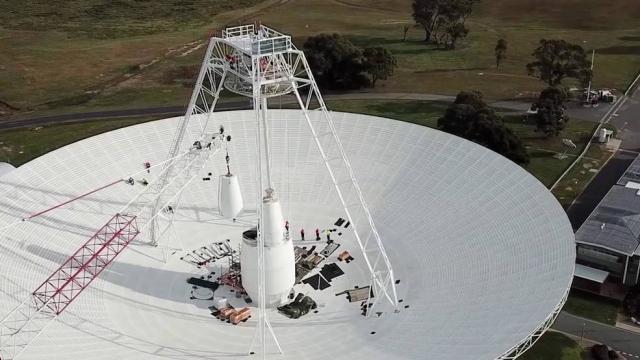Mission operators have been unable to send radio transmissions to the Voyager 2 space probe since mid-March, but a recent test of newly installed hardware is a good sign that upgrades to NASA’s Deep Space Network are proceeding as planned.
NASA sent a command to Voyager 2 on October 29, something it hadn’t been able to do for seven months, according to an agency statement. Mission operators did so using Deep Space Station 43 (DDS43) — the only radio antenna capable of communicating with the spacecraft. Launched in 1977, Voyager 2 is currently 18,792 million km from Earth. It and its partner Voyager 1 are the most distant human-made objects in the universe.
The radio antenna has been offline due to much-needed repairs and upgrades. The successful re-connect wasn’t supposed to happen for another three months, but the early test of newly installed hardware, in which Voyager 2 returned a “hello” signal as commanded, is good news, as the facility is expected to go back online in February 2021.
NASA couldn’t talk to Voyager 2 during the seven-month break, but the probe was beaming back health updates and important science information. The probe is currently travelling through the heliosphere at 55,160 km per hour, where it’s exploring this expansive, bubble-like region of the outer solar system.
The Deep Space Network is a collection of radio antennas located around the world, and its primary purpose is to communicate with spacecraft farther away than the Moon. Located in Canberra, Australia, DDS43 is an import cog in this system, but, at 48 years old, it was sorely in need of of a refresh. The 33.83 m-wide radio antenna has gone through upgrades before, but this represents the longest time it has been offline in over 30 years.
“The DSS43 antenna is a highly specialised system; there are only two other similar antennas in the world, so having the antenna down for one year is not an ideal situation for Voyager or for many other NASA missions,” Philip Baldwin, operations manager for NASA’s Space Communications and Navigation (SCaN) program, said in the statement. “The agency made the decision to conduct these upgrades to ensure that the antenna can continue to be used for current and future missions. For an antenna that is almost 50 years old, it’s better to be proactive than reactive with critical maintenance.”
These repairs and upgrades will prove beneficial to other missions, including Mars Perseverance (currently en route to the Red Planet) and the upcoming Artemis missions to the lunar surface, not to mention future trips to Mars involving humans.
That only one radio dish on Earth can communicate with Voyager 2 may sound surprising, but there’s a very good reason for this. For the probe to make a flyby of Neptune’s moon Triton in 1989, mission operators had to send the probe over the ice giant’s north pole. This trajectory required the probe to travel in a southerly direction relative to the flat orbital plane, and it’s been moving in this direction ever since. The consequence of this manoeuvre is that Voyager 2 has now travelled so far south of the planetary plane that it can’t be reached by radio antennas on Earth’s Northern Hemisphere. The probe’s sibling, Voyager 1, can still be reached by a pair of dishes in the Northern Hemisphere, as the probe took a different path, past Saturn.
DSS43 is also the only dish in the Southern Hemisphere with a transmitter powerful enough to reach Voyager 2, while also being capable of speaking the right language; uplinks to Voyager 2 must be transmitted in the S-band, while downlinks must be received in the X-band.
Two-way communication with Voyager 2 has been restored, as this machine keeps on keeping on. But, imagine that: No contact with Earth for months and months at a time. Sounds absolutely dreamy.
